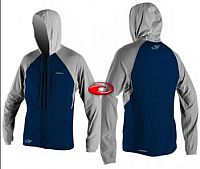What To Wear While Surfski Paddling

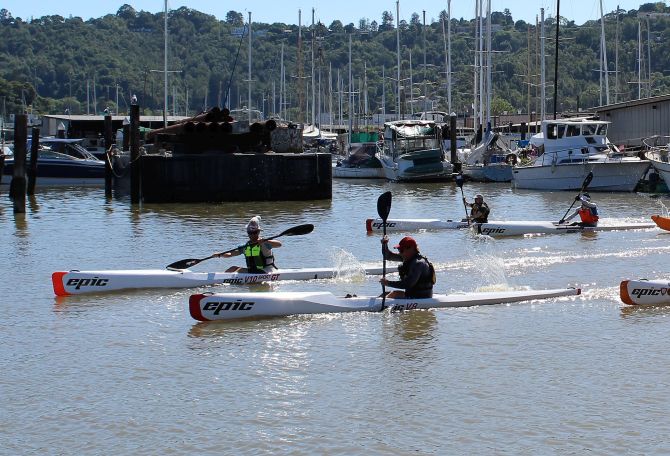
One of the biggest challenges for the San Francisco Bay Area paddler is deciding what to wear and when wear it, while kayaking or paddling surfski on The Bay. With the dramatic temperature variables of water and air at play, and the possibility of a capsize and swim, choosing the right gear can make the difference between a good day or a bad day on the water.
To add to the complexity the paddler themselves makes a big difference in the overall solution. A more recreational paddler will require more warmth than the fitness-oriented workout paddler who is producing more body heat through their aerobic workout. Kayakers and Surfski paddlers need more thermal protection than Stand Up Paddleboarders and Outrigger Canoe paddlers because water that is flicked up by the blades of the paddle combined with the wind will keep you cool. Some key features to consider are warmth, flexibility, water repellency, dry time, breathability, wind proofing, and then of course the ever present need to be somewhat fashionable. My dad always said, “If your head is in the oven and your feet are in the freezer, on average you are OK.” This encapsulates the problem of being comfortable standing in the parking lot pre paddle and having apparel that works after falling in after 30 minutes of hard paddling on a cold day. Good technical apparel can solve these problems.
With all these factors in motion we have developed what we call the San Francisco Bay Paddling Apparel Ladder. The ladder is designed for flat water paddling which is deemed as anything other than down winding or surfing. This includes windy, rougher, and even rainy conditions but not breaking surf or downwind situations where full wetsuits are generally the call.
Before we jump in to the details let’s talk a bit about safety and the rule of 100. The rule basically goes like this; if the water + the air temp are not greater than 100 then consider not going out. With San Francisco Bay water temperatures generally between 54 and 62 degrees you can do the math from there. With that said, paddling below the rule of 100 is possible, it just requires very specialized gear and some additional safety measures. one more axiom of safety comes to us from the world of Outdoor Leadership – “Cotton Kills”. When cotton becomes wet it actually speeds body cooling which can accelerate hypothermia. In addition it holds lots of water making it quite heavy when wet – think sea anchor. We’ll touch on the rule of 100 again at the very end but let’s start with defining some of the variables.
- Paddling effort - As you read this consider the level of effort you apply while paddling. If you are race training you are generating a lot more heat than if you are out sightseeing. The slower you paddle the warmer your gear needs to be. The harder you paddle the more breathability you will need.
- Likelihood of falling in – The more likely you are to fall in the water the more likely you will need Neoprene.
- Rain? Think neoprene. Neoprene insulates better when wet or immersed better than any other material.
- Fit – Good on-the-water apparel is generally snugger fitting than your standard leisure wear. Keeping the apparel close to the body increases warmth and reduces wind drag.
- Materials – You likely have some items in your closet that are good for water wear – Lycra, Nylon, Spandex, Polyolefin, Poly propylene. Biking, Yoga, and workout apparel for example are usually blends of these non-natural fibers. Look for the words “Hydrophobic”, “Water Resistant”, “Water Repellant”. Be cautious of the words “Water Proof”, as they often have poor breathability.
- Paddling Area – The bay is famous for its microclimates. Know your route and dress for the worst conditions you may encounter.
So let’s take that first step on the ladder. A nice calm day on San Francisco Bay in the summer.
Apparel Ladder Step One – The Summer Time Outfit
-
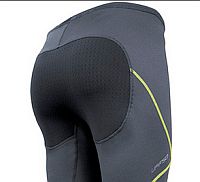 Weather - Nice day flat water cool/warm
Weather - Nice day flat water cool/warm - Falling in? – Highly unlikely but might happen so be prepared (no cotton)
- Materials – Lycra, Polyester, Spandex, Nylon etc….
- Suggested Apparel –Lightweight synthetics with boardshorts and Lycra garments the standard fare. Consider lightweight neoprene booties 2mm or less. They can add to comfort while standing and foot protection in the parking lot and on rocky beaches. O’Neill Hyperfreak Rash Guards, O’Neill Boardshorts, O’Neill Reef Walker, or Superfreak Booties.
- Specialized Gear - We do carry a line of apparel that is designed specifically for Outrigger Canoe Paddling that is also great for Surfski and Kayakers. Dakine makes some great shorts with reinforced seats (pictured at right), leggings with a padded seating area, and some really nice jackets as well.
A special note about all apparel and one that may save your life. Don’t Get Burned! Even on the warmer days look to cover as much skin as possible. Make sure your apparel is UPF rated to at least 30 and ideally 50. Clothing is your best sunscreen and today’s high-tech fabrics are unlikely to cause you to overheat. So cover up!
Ladder Step Two – A chill is in the air
-
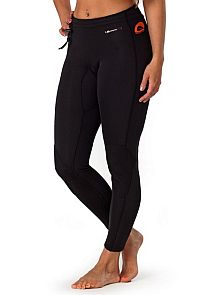 Weather - Cold, as in under 60 degrees with low winds and cold water
Weather - Cold, as in under 60 degrees with low winds and cold water - Falling In? - Still unlikely but possible. You should be to be quick in quick-dry apparel if it does happen.
- Materials - In our experience a fleeced Lycra sometimes also known as a Thermal Rash guard is the best choice for such conditions. Polypropylene and Polyolefin are two materials that work well. The material will be wet after the initial exit from water but will maintain some warmth and quick-dry in 10-15 minutes.
- Suggested Apparel - Booties are now a must. Consider 2mm or even 3mm booties. You can read some detailed information on the best booties by clicking here. Thermal Tights from Starboard, or SUPreme’s Contour pants are a good choice for your bottom half. O’Neill Themo (8oz) & Thermo X (13oz) thermal rash guard work great on the top side of things. You may opt to wear a jacket but make sure it has a front zipper and lightweight sleeves. A zippered garment offers easy venting. It also better enables layering. Having a jacket that can turn in to a fanny pack is a nice option for when you discover you have overdressed. Our favorite is the Supertech from O’Neill. Recreational paddlers should consider a 2mm Farmer John/Jane wetsuit with a lightweight synthetic top which will offer greater warmth and immersion protection.
- Fashion Note – Board shorts over tights is the generally accepted preference for guys.
Ladder Step 3 – It’s really cold but I gotta get my fix!
- Weather - Really cold (under 55 degrees) with cold water. It’s winter.
- Falling In? High likely hood of falling in or while paddling in rain. The consequences of falling now more severe from a safety stand point.
- Apparel –Go Hybrid. Hybrid means some blend of neoprene along with other synthetics like polyester blends. These products will contain neoprene in the .5mm to 2mm range. In the areas of stretch – shoulders, arms etc. is where the synthetics are often used. You may opt for full neoprene in the .5mm thickness for greater flexibility in a neoprene garment. Consider wind protection as well. Neoprene can be porous to the wind while “smooth skinned” or “coated neoprene” acts like a barrier. For the active paddler, keep the sleeves somewhat lighter while covering the core in neoprene. O’Neill Supertech Jacket (pictured at right), SUPreme Hybrid. 3mm Booties a must. O’Neill Heat Booties, Dakine Paddlers Jacket, Dakine Paddle Pants, Hyperfreak Neoprene Hybrid, SUPreme Catch (his) or Reach (hers) Jacket. NRS Hydroskins, SUPreme Contour Neoprene Pants. Front Zippered apparel is still a good option to allow for venting if you find yourself overdressed. Farmer Jane and Farmer Johns with matching hybrid or neoprene jackets are good options for recreational paddlers. Consider a 2mm Neoprene Beanie from O’Neill or SUPreme. Easy to stash if it ends up being too much.
- Note – Wind is a wild card here. Polyolefin, Polypropylene, Lycra and the other synthetics are quite porous which is good for breathability but will allow wind to cut right through it. If the wind is up then consider neoprene as a better option. A nylon or Gore-Tex shell over the poly blends can help the recreational paddler but will generally over heat the fitness paddler.
Ladder Step 4 –It’s early morning in January with wind and will probably rain too and hell yes I am paddling! (under 100)
-
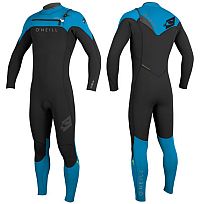 Weather – Very cold and/or windy. Rainy Day with pretty frequent rain.
Weather – Very cold and/or windy. Rainy Day with pretty frequent rain. - Falling in? – Likely to happen with rain saturation a concern.
- Apparel - 2 mm full neoprene wetsuits with short sleeves or a 3/2 Full Wetsuit. The active paddler who is training may still want their arms exposed to reduce over-heating. The exposed arms act as radiators to remove heat from the core. If you are colder than you should opt for a 3/2 Full. 3/2 indicates the thickness of the neoprene with 3 millimeter in the core and 2 millimeters on the limbs. Recreational paddlers by definition are staying home. 3mm Booties a must and colder paddlers may opt for the O’Neill Heat 5mm Booties . O’Neill Epic 2mm Full suit with short sleeves or the O’Neill Hyperfreak 3/2 full wetsuit. Another option is the layered approach building on the 2mm Farmer John/Jane and adding a full 2mm neoprene front zippered jacket. Colder folks may want the 2mm neoprene Beanie. Consider some Neoprene gloves can also help keep the hands warm.
Ladder Step 5 – Its cold but your nuts! Don’t feel bad we are right there with you. (under 100)
- Weather – Sub 40 degree air temps, wind, and rain. It’s frigid.
- Falling in? – Must be prepared as the consequences of falling in with the wrong gear could result in death. No Joke.
- Apparel – A 4/3 full neoprene wetsuit that includes covered arms is the bare minimum. Neoprene Gloves and 3mm neoprene hood are a must. 5mm Booties are recommended. The ultimate in warmth and safety is the dry suit. We prefer the suits from Ocean Rodeo. These suits can be a pain to get in and out of, but due to the sealed environment you can wear the apparel of your choice underneath. In addition these new suits from Ocean Rodeo actually are breathable AND waterproof. This makes the Ocean Rodeo Drysuit the ultimate cold water attire for surfskis and kayakers. We look forward to getting our hands on the new Starboard dry suits (pictured below) but as of this time of we have not had the chance to use them.
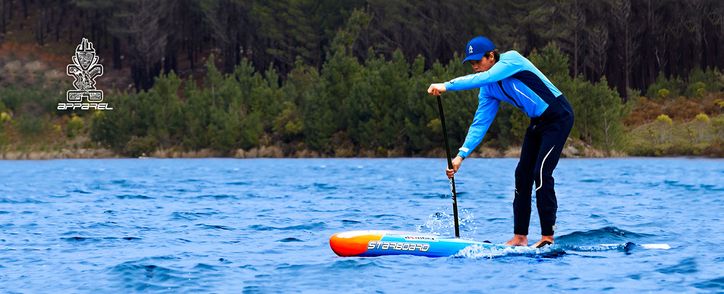
Some follow up notes on safety when paddling in colder conditions. First try not to paddle alone. Bringing a buddy is a good idea. Always let someone who is not paddling know where you are going and about what time you should be back - aka a Float Plan. Bring a cellphone in a waterproof bag along, a waterproof VHF radio, and a small snack or energy bar. Dress for success with a bias for wearing too much. ALWAYS wear a leash and a lifejacket. And our final axiom for safety “When in doubt – don’t go out.”
Stay tuned to our blog or sign up for our newsletter as we’ll be adding more informative articles on apparel for surfing and downwinding in the future.

